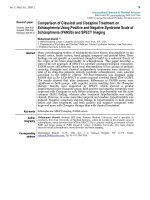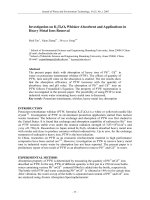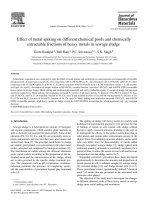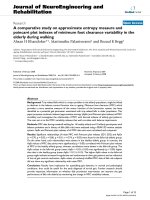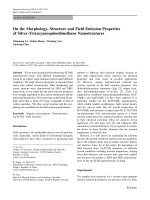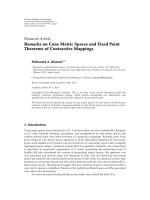Investigation on anti prion, neuroprotective and anti cholinesterase activities of acridine derivatives
Bạn đang xem bản rút gọn của tài liệu. Xem và tải ngay bản đầy đủ của tài liệu tại đây (2.97 MB, 292 trang )
INVESTIGATION OF ANTI-PRION, NEUROPROTECTIVE
AND
ANTI-CHOLINESTERASE ACTIVITIES OF ACRIDINE
DERIVATIVES
NGUYEN THI HANH THUY
(B. Sc. (Pharmacy) (Hons), NUS)
A THESIS SUBMITTED
FOR THE DEGREE OF DOCTOR OF PHILOSOPHY
DEPARTMENT OF PHARMACY
NATIONAL UNIVERSITY OF SINGAPORE
2010
i
Acknowledgements
I would like to express my heartfelt gratitude and appreciation to my supervisor,
Assoc. Prof. Go Mei Lin for her immeasurable guidance and support throughout the
course of my research study. I would not have gone a very good academic training
without the opportunities she gave me. I have learnt so much from her invaluable advices
and discussion.
I would like to acknowledge Prof. Katsumi Doh-ura for allowing me to work in
the Prion lab in Tohoku University, Sendai, Japan. Not only did he share his expertise in
the prion field, he also helped me settle down into a new environment quickly. Thanks to
all lab members for welcoming me to the labs, teaching me the experiments and
introducing me to a totally new culture.
Special thanks to Assoc. Prof. Ong Wei Yi who has provided his input, support,
and insights to my PhD project.
My gratitude to Ms Oh Tang Booy, Ms Ng Sek Eng, and all technical and
research staffs in Pharmacy department for their prompt support and sharing technical
knowledge with me. Many thanks to Dr Suresh Kumar Gorla for sharing his expertise in
organic synthesis, Yeo Wee Kiang for his experience in molecular modeling. My
gratitude to all postgraduate students and final year undergraduate students in the
Medicinal Chemistry lab for sharing the lab life with me. The National University of
Singapore Research Scholarship is gratefully appreciated.
Last but not least, I owe thanks to my parents, my sister, and my husband for their
unconditional love and unwavering support. Thanks my close friends who have gone
through thick and thin with me for the whole 8 years in Singapore.
ii
Table of Contents
Acknowledgements i
Table of Contents ii
Publications and Conferences ix
Summary x
List of Abbreviations xiii
Chapter 1: Introduction 1
1.1 Antimicrobial activity 1
1.2 Anticancer activity 4
1.3 Efficacy in neurodegenerative conditions 7
1.3.1 Prion diseases 8
1.3.2 Oxidative stress and protein misfolding diseases 12
1.3.3 Prion diseases and other protein misfolding conditions 14
1.3.3 The antiprion activity of quinacrine and other acridine derivatives 15
1.4 Statement of purpose 19
Chapter 2: Design and synthesis of 9-aminoacridine analogs 22
2.1 Introduction 22
2.2 Design approach 22
2.2.1 Group 1 23
2.2.2 Group 2 24
2.2.3 Group 3 26
2.2.4 Group 4 27
2.2.5 Group 5 28
iii
2.2.6 Groups 6 and 7 29
2.3 Chemical considerations 30
2.3.1 N-substituted 9-aminoacridines 31
2.3.2 General approach to the synthesis of the 9-aminoacridines of Group
1-5 34
2.3.3 Synthesis of substituted anulines for Groups 2,6, and 7 by Hartwig-
Buchwald amination reaction 36
2.3.4 Synthesis of N
1
,N
1
-dimethylbenzene-1,2-diamine 38
2.3.5 Synthesis of N
1
,N
1
-diethylbenzene-1,3-diamine 38
2.3.6 Synthesis of 4-[(4-methylpiperazin-1-yl)methyl] aniline, 4-
(piperidin-1-ylmethyl)aniline and (4-aminophenyl)(4-
methylpiperazin-1-yl)methanone] 39
2.3.7 Synthesis of 1-benzyl-piperidin-4-ylamine, 1-phenethylpiperidin-4-
ylamine, 1-(3-phenylpropyl)piperidin-4-ylamine and their ring
substituted analogs 40
2.3.8 Synthesis of 4-chlorobenzylchloride 41
2.3.9 Synthesis of 4-(4-methyl-piperaziny-1-yl)-but-2-ynylamine 41
2.3.10 Synthesis of 8-benzyl-8-aza-bicyclo[3.2.1]oct-3-ylamine 42
2.3.11 Synthesis of the 3,9-dichloro-5,6,7,8-tetrahydroacridine 43
2.3.12 Synthesis of 6-chloro-2-methoxyacridin-9-amine
monohydrochloride (46) 43
2.3.13 Synthesis of 6-chloro-1,2,3,4-tetrahydro-acridin-9-ylamine (49) and
7-chloroquinolin-4-amine (55) 44
iv
2.4 Experimental methods 45
2.4.1 General experimental methods 45
2.4.2 General procedure for the reaction of 2-methoxy-6,9-
dichloroacridine, 9-chloroacridine and 4,7-dichloroquinoline with
amines in ethanol as solvent (GP1) 45
2.4.3 General procedure for the reaction of 2-methoxy-6,9-
dichloroacridine, 3,9-dichloro-5,6,7,8-tetrahydroacridine and 4,7-
dichloroquinoline with amines in phenol as solvent (GP2) 46
2.4.4 Synthesis of the 3,9-dichloro-5,6,7,8-tetrahydroacridine 47
2.4.5 Synthesis of 6-chloro-1,2,3,4-tetrahydro-acridin-9-ylamine (49) 47
2.4.6 Synthesis of 4-amino-7-chloroquinoline (55) 48
2.4.7 6-Chloro-2-methoxyacridin-9-amine monohydrochloride (46) 48
2.4.8 Synthesis of substituted nitrobenzenes for Groups 2, 5, 6, and 7 by
Hartwig-Buchwald amination reaction (GP3) 49
2.4.9 General procedure for catalytic reduction of substituted
nitrobenzenes (GP4) 51
2.4.10 Synthesis of N
1
,N
1
-dimethylbenzene-1,3-diamine 52
2.4.11 Synthesis of N
1
,N
1
-diethylbenzene-1,3-diamine 52
2.4.12 Synthesis of 4-[(4-methylpiperazin-1-yl)methyl] benzenamine 53
2.4.13 Synthesis of 4-[(piperidin-1-yl)methyl]benzenamine 53
2.4.14 Synthesis of (4-aminophenyl)(4-methylpiperazin-1-yl)methanone 54
2.4.15 Synthesis of amines for Group 3 54
2.4.16 Synthesis of 4-(4-methylpiperazin-1-yl)but-2-yn-1-amine 57
v
2.4.17 Synthesis of 8-benzyl-8-aza-bicyclo[3.2.1]octan-3-amine 59
2.4.18 Synthesis of 1-chloro-4-(chloromethyl)benzene 60
2.4.19 Synthesis of 1-chloro-4-(2-chloroethyl)benzene 60
2.5 Summary 61
Chapter 3: Antiprion activity of acridine analogues 62
3.1 Introduction 62
3.2 Experimental methods 64
3.2.1 Evaluation of antiprion activity 64
3.2.2 Determination of total and cell surface prion proteins 65
3.2.3 Evaluation of binding affinity by surface plasmon resonance 66
3.2.4 Evaluation of permeability by the PAMPA-BBB assay 67
3.2.5 Cell-based bidirectional transport assay 69
3.2.6 Statistical analysis 71
3.3 Results 71
3.3.1 Antiprion activity of compounds on cell-based models 71
3.3.2 Effect of lipophilicity on antiprion activity 93
3.3.3 Evaluation of binding affinities of test compounds to human PrP121-
231 by surface plasmon resonance 94
3.3.4 Evaluation of selected compounds for effects on the expression of
total and cell-surface PrP
C
by uninfected mouse neuroblastoma cells
(N2a) 101
3.3.5 Evaluation of the potential of test compounds to transverse the blood
brain barrier 104
vi
3.4 Discussion 112
3.5 Conclusion 116
Chapter 4: Protection of mouse hippocampal HT22 cells against glutamate induced
cell death 117
4.1 Introduction 117
4.2 Experimental methods 120
4.2.1 Materials 120
4.2.2 Cell culture 121
4.2.3 Cytotoxicity assay 122
4.2.4 Determination of glutathione content 123
4.2.5 Determination of Trolox Equivalent Antioxidant Capacity (TEAC)
values 125
4.2.6 Determination of intracellular ROS levels 127
4.2.7 Determination of mitochondrial ROS levels 128
4.2.8 Determination of cytosolic calcium levels 129
4.2.9 Statistical analysis 129
4.3 Results 130
4.3.1 Effects of test compounds on glutamate induced cell death of HT22
cells 130
4.3.2 Effect of incubation time on protective effects against glutamate-
induced cell death 143
4.3.3 Effects of compounds 16, 25, 45 and 46 on glutathione levels in
HT22 cells challenged with glutamate 148
vii
4.3.4 Quenching of the nitrogen based ABTS
•+
cation radical by test
compounds 150
4.3.5 Effects of compounds 16, 25, 45 and 46 on intracellular ROS
production 157
4.3.6 Effects of compounds 16, 25, 45 and 46 on intracellular calcium
levels 161
4.4 Discussion 163
4.5 Conclusion 167
Chapter 5: Anti-cholinesterase activity of synthesized compounds 169
5.1 Introduction 169
5.2 Experimental methods 173
5.2.1 Determination of inhibitory effects on AChE and BChE 173
5.2.2 Molecular modeling 175
5.3 Results 176
5.3.1 AChE and BChE inhibitory activities 176
5.3.1.1 Inhibition of AChE and BChE at a fixed concentration (3
µM) of test compound 177
5.3.1.2 AChE and BChE inhibitory activities of selected
compounds based on IC
50
determination 186
5.3.1.3 Kinetics of the inhibition of AChE/BChE by tacrine and
compounds 47, 49-51 193
5.3.2 Docking of tacrine, compounds 49 and 51 onto the AChE and BChE
binding pockets 198
viii
5.3.2.1 Docking of tacrine, 49 and 51 to Torpedo AChE (1ACJ) 199
5.3.2.2 Docking of donepezil, tacrine, 49 and 51 to Torpedo AChE
(1EVE) 205
5.3.2.3 Docking of tacrine, 49 and 51 to BChE 215
5.4 Discussion 217
5.5 Conclusion 221
Chapter 6: Conclusions and future work 223
References 231
Appendix 1: Spectroscopic data, yield, and retention time of synthesized compounds
245
Appendix 2: Liquid chromatography tandem mass spectrometry 269
Appendix 3: ClogP and SlogP values 272
Appendix 4: ClustalW2 sequence alignment of TcAChE (PDB code 1ACJ) and
hAChE (PDB code 1B41) 274
Appendix 5:Superimposing 3D structures of TcAChE and hAChE using MOE 276
ix
Publications and Conferences
Hanh Thuy Nguyen Thi, Chong-Yew Lee, Kenta Teruya, Wei-Yi Ong, Katsumi Doh-ura,
Mei-Lin Go. Antiprion activity of functionalized 9-aminoacridines related to quinacrine.
Bioorganic & Medicinal Chemistry (2008), 16(14), 6737-6746
Nguyen, T.H.T., Go. M. L. Investigation on neuroprotective potential of acridine
derivatives. Poster presentation at the Medicinal Chemistry Symposium. Jan 2008.
National University of Singapore.
Nguyen, T.H.T; Lee, C.Y.; Ong, W.Y.; Doh-ura, K.; Go, M.L. Investigation on antiprion
activities of acridine derivatives. Poster presentation at the European school of medicinal
chemistry. Symposium of medicinal chemistry in neurodegerative diseases July 2008.
Urbino, Italy.
x
Summary
The objective of this thesis was to investigate the activity of functionalized
aminoacridines in neurodegenerative conditions. To this end, a library of forty acridine
derivatives and several related tetrahydroacridine and quinoline analogues were
synthesized and evaluated for (i) antiprion activities against different prion strains
including two mouse strains (RML and 22L) and one human strain (Fukuoka-1) (ii)
neuroprotection against glutamate-induced oxytosis (iii) anti-acetylcholinesterase and
anti-butyrylcholinesterase activities. The compounds were classified into seven groups
based on nature of side chain and ring template.
Almost all the compounds demonstrated activity on the murine RML strain-
infected neuroblastoma (ScN2a) model, with EC
50
values ranging from 0.03 µM to 4 µM.
A number of compounds were active on the 22L strain-infected cells (N167) model as
well as cells overexpressing cellular prion (Ch2) model. Most importantly, some Group 2
and Group 3 compounds were more potent than quinacrine on PrP
C
-overexpressed
neuroblastoma cells infected with a human prion strain (F3 model) with EC
50
values at a
low micromolar range. They were also able to clear aggregates of abnormal prion
proteins (PrP
Sc
) completely at a concentration less than 3 µM. Surface plasmon resonance
revealed that the compounds bind to PrP
C
. The high lipophilicity of the 9-aminoacridined
contributes to its potential to cross the blood brain barrier as demonstrated from the
PAMPA-BBB assay. One analog which was active on all four tested prion models had a
lower susceptibility to be a Pgp substrate when tested on a cell monolayer overexpressing
Pgp. Thus, the 9-aminoacridine template was found to be a promising template from
xi
which potential antiprion agents with good in vitro potencies and drug-like properties for
BBB permeability may be derived.
An –NH– group flanked by a phenyl and an acridine is crucial for
neuroprotection against glutamate-induced oxytosis. The compounds were able to
“rescue” cells exposed to 5mM glutamate for up to 12 hours. All 9-
(phenylamino)acridines were able to quench ROS level as seen from the TEAC assay.
These compounds effectively reduced the mitochondrial ROS levels and the intracellular
Ca
2+
level. Both these mechanisms were late-stage events linked to glutamate-induced
cell death and were proposed to contribute to the latent protective effects of the active
compounds.
The optimal ring scaffold for AChE inhibition was the 6-chlorotetrahydroacridine
ring which had low nanomolar IC
50
values. The side chain determined potency and
selectivity for AChE versus BChE inhibition. The 1-benzyl-4-piperidinyl side chain was
associated with the most potent activity. Most of the compounds were mixed inhibitors of
AChE and competitive inhibitors of BChE. Compounds with the 6-
chlorotetrahydroacridine template (Group 6) and those that had 1-benzyl-4-piperidinyl
side chains attached to the 6-chloro-2-methoxyacridine ring (Group 3) were more
selective inhibitors of AChE compared to BChE. Docking of active compounds onto the
crystal structures of AChE and BChE shed light on the binding mode of these
compounds.
In conclusion, this thesis had shown that functionalized aminoacridines were
attractive starting points for the design of compounds for antiprion activity, inhibition of
xii
oxytosis and inhibition of AChE. While structural requirements for these activities were
different, they are found in compounds that bear a common template.
xiii
List of abbreviations
ABTS: 2,2’-azino-bis(3-ethylbenzthiazoline-6-sulphonic acid)
Aβ: amyloid-β peptides
AChE: acetylcholinesterase
AD: Alzheimer’s disease
m-AMSA: Amsacrine
APCI: atmospheric pressure chemical ionization
BBB: blood brain barrier
BChE: butyrylcholinesterase
BCRP: breast cancer resistant protein
BINAP: 2,2’-bis(diphenyl phosphino)-1,1’-binaphthyl
BSA: bovine serum albumin
CJD: Cruetzfeldt-Jakob disease
13
C NMR: carbon-13 nuclear magnetic resonance
DACA: N-(2-dimethylamino)ethyl)acridine-4-carboxamide
DMEM: Dulbecco’s modified Eagle’s medium
DMSO: dimethyl sulfoxide
DPPD: N,N-diphenyl-p-phenylenediamine
DTNB: dinitrothiocyanobenzene
EC
50
: the concentration of substance that provides 50% of the maximum activity
ER: endoplasmic reticulum
ESI: electron spray ionization
FAA: full antiprion activity
xiv
FBS: fetal bovine serum
GPI: glycosyl phosphatidylinositol
GSH: glutathione
GSS: Gerstmann-Sträussler-Scheinker syndrome
HBSS: Hank’s buffered saline solution
H
2
DCF: 2’,7’-Dichlorofluorescein diacetate
1
H NMR: proton nuclear magnetic resonance
HPLC: high performance liquid chromatography
IC
50
: the concentration of substance that provides 50% of the maximum inhibition
LC/MS/MS: Liquid chromatography/Mass spectrometry/Mass spectrometry
MS: mass spectra
MTT: 3-(4,5-dimethylthiazol-2-yl)-2,5-diphenyltetrazolium bromide
NAPDH: nicotinamide adenine dinucleotide phosphate
PAMPA-BBB: parallel artificial membrane permeation assay for blood brain barrier
permeability
PAS: peripheral anionic site
PBS: phosphate buffer saline
Pgp: P-glycoprotein
PI: propidium iodide
PMSF: phenylmethanesulphonyl fluoride
PMD: protein misfolding disorder
PrP: prion protein
PrP
C
: cellular prion protein
xv
PrP
Sc
: scrapie prion protein
RU: response unit
ROS: reactive oxygen species
SAR: Structure-activity relationship
SDS PADE: sodium dodecyl sulfate polyacrylamide gel electrophoresis
SPR: surface plasmon resonance
TC: tolerant concentration
TEAC: Trolox equivalent antioxidant capacity
TEER: transepithelial electrical resistance
TLC: thin layer chromatography
TSE: transmissible spongiform encephalopathies
1
Chapter 1: Introduction
Acridine is a nitrogen heteroaromatic compound that is structurally related to
anthracene (Figure 1.1). In acridine, the –CH= in the central ring of anthracene is
replaced by an azomethine nitrogen (-N=), the presence of which imparts basicity to the
heterocycle. Acridine is a weak base with a pK
a
of 5.6 that is comparable to that of
pyridine.
N
1
2
3
45
6
7
8
9
10
Figure 1.1: Structure and numbering of acridine (also known as dibenzo(b,e)pyridine,
2,3,5,6-dibenzopyridine, 2,3-benzoquinoline, 10-azaanthracene)
Acridine itself has no therapeutic utility but functionalized acridines like
aminoacridines, and reduced acridines like tetrahydroacridines are represented in several
important drugs. This has boosted the reputation of acridine as a privileged scaffold and
explains the sustained interest in this template for drug design, particularly for agents
targeted against microbial infection, cancer, neurodegeneration and inflammation.
1.1 Antimicrobial activity
The first antimicrobial acridines were dyestuffs, namely acriflavine which was
found to possess activity against the parasitic disease trypanosomiasis by Ehrlich and
Benda in 1912 and proflavine whose antibacterial activity was reported by Browning in
2
1913.
1
Acriflavin was subsequently found to have antibacterial activity, which led to
widespread use of acriflavin and proflavin as wound antiseptics during the First World
War. Interest in the antimicrobial activitiy of acridines continued unabated after the War
and resulted in the development of cyanine and styryl derivatives of quaternary acridines,
quinolines and phenazines,
1
as well as quinacrine which was widely employed as an
antimalarial substitute for quinine during the ensuing Second World War.
2
The post-war
period of the 1940s and 1950s saw a decline in research interest in the antibacterial
properties of acridines due to the discovery of the highly efficacious penicillins as
antibiotics in the 1950s. Nonetheless, antibacterial acridines like proflavin and acriflavin
are remembered to this day for plugging the “antibacterial gap” between Ehrlich’s
Salvarsan and Fleming’s penicillin. The research of Steck et al.
3
on anti-rickettsial
acridines and Elslager et al.
4
on anti-bacterial acridine N-oxides were the last major
investigations on the antimicrobial properties of acridines.
5
Ironically, it was a better
understanding of the antibacterial activity of the acridines that caused the waning of
interest.
Figure 1.2: Structures of early acridine-based antimicrobials.
Nucleic acids are the established sites of action of aminoacridine derivatives in
bacteria. The planar tricyclic acridine nucleus intercalates perfectly between nucleotide
base pairs in the DNA helix, with the positively charged acridinium moiety directed
3
towards the negatively-charged phosphate groups. The principal driving forces for
intercalation are stacking and charge-transfer interactions, with hydrogen bonding and
electrostatic forces playing stabilization roles. Intercalation destroys the regular helical
structure of DNA, causing it to unwind at the site of binding and consequently interfering
with the action of the DNA-binding enzymes (DNA topoisomerases, DNA polymerases).
In fact, the targeting of nucleic acids by acridines open a new front for their deployment
as anticancer agents as described in Section 1.2. However, it also raised misgivings over
the widespread use of acridines as main stream antibacterials for fear that its intercalating
properties would result in undesirable frameshift mutagenesis in mammalian cells. These
fears had since been challenged by investigations demonstrating that simple intercalators
like acridines were weak clastogens and not associated with widespread mutagenic
properties.
6,7
The intercalating propensity of the acridine template is influenced by the type of
substituents on the ring. Introducing bulky substituents such as propyl and tertiary butyl
groups resulted in analogues that were significantly weak intercalators.
8
The presence of
a methyl group at C2 of 9-aminoacridine was also reported to diminish both DNA
intercalative ability and mutagenicity.
9
The past decade had seen a modest resurgence in the research on antimicrobial
acridines, prompted in part by the growing resistance to available drugs. Denny and co-
workers described structure-activity relationships for the antileishmanial and
antitrypanosomal activities of 1’-substituted-9-anilinoacridines.
10
Guetzoyan et al.
reported new 9-substituted acridyl derivatives that were active against chloroquine-
resistant strains of Plasmodium falciparum.
11
Biagini and co-workers designed
4
dihydroacridinediones as potent antimalarials with nanomolar IC
50
values and greater
selectivity for the parasite (and not host) mitochondrial bc1 complex.
12
More recently,
hybrid molecules designed from 4-aminoquinoline and clotrimazole resulted in potent
and selective antimalarials with promising pharmacokinetic profiles.
13
1.2 Anticancer activity
The ability of the acridine ring to intercalate within the double-stranded DNA
structure forms the basis of its anticancer activity. For most of these acridines, their
cytotoxicity is determined not only by its affinity for DNA but the ability to form a
relatively stable complex with DNA that can inhibit the topoisomerase enzymes. Briefly,
topoisomerases play a crucial role in the control of the structural organization of DNA in
cells and in the release of negative and positive constraints generated by DNA
replication, transcription and repair processes. To release the constraints on the global
structure of DNA, topoisomerase I makes transient cleavages on one strand of the DNA
double helix
14
while topoisomerase II breaks both strands of the duplex.
15,16
This leads to
the formation of a covalent topoisomerase-DNA complex (“cleavable complex”) which
in normal cells will break down to restore a native relaxed DNA strand and the free
functional enzyme. This process can be inhibited at various levels such as the DNA
binding or DNA cleavage step, but the most potent inhibitory process in terms of cellular
toxicity is the stabilization of the cleavable complex through inhibition of the re-ligation
step. Two major families of acridines were identified to act in this manner, namely the 9-
anilinoacidines represented by amsacrine (m-AMSA) and carboxamidoacridines of which
DACA [N-(2-dimethylamino)ethyl)acridine-4-carboxamide] is an example (Figure 1.3).
5
N
HN
H
3
CO NHSO
2
Me
Amsacrine (m-AMSA)
N
ON
H
N
DACA
N
N
N
O
Ascididemin
Figure 1.3: Structures of representative topoisomerase inhibitors.
Amsacrine (m-AMSA) has been used as an antileukaemic agent since 1976. Its
mode of action involves the stabilization of the topoisomerase II - DNA complex
17
by
intercalation of the acridine ring
18
and specific interactions between the substituted
aniline ring and the enzyme.
19
Modification of substituents on the acridine core and 9-
anilino moiety had resulted in interesting novel AMSA-like derivatives like 3-(9-
acridinylamino)-5-(hydroxymethyl)anilines (AHMA),
3
5-(9-acridinylamino) toluidines
20
and anisidines
21
which were more potent as anticancer agents and less toxic to the host.
While most topoisomerase inhibitors were selective towards either topoisomerase
I or II, DACA was unusual in its ability to inhibit both enzymes. DACA was evaluated in
phase II clinical trials for efficacy against non-small cell lung cancer and advanced
ovarian cancer
22,23
but further trials were discontinued in the face of poor results.
Quadruplex nucleic acids are four-stranded structures comprising short tracts of
guanine (G)-rich sequences that are held together by intervening sequences (loops).
24
Their occurrence has been extensively characterized at the telomeric ends of eurkaryotic
chromosomes, whose DNA consists of tandem repeats of the sequence d[(TTAGGG)
n
]
and where the extreme 3’ ends are single stranded.
25
These guanine-rich single strands
can adopt higher–ordered and functionally useful G-quadruplexes.
26
The induction and
6
stabilization of telomeric G-quadruplexes by small molecules interfere with telomere
function, inhibit telomerase activity and eventually alter telomere maintenance.
27-29
Telomere maintenance is necessary if cancer cells are to retain their unlimited
proliferative potential,
30,31
thus the design of drugs targeting the telomeric G-quadruplex
is a rational and promising approach for cancer chemotherapy.
32
Several acridines were
identified as selective ligands for the telomeric G-quadruplex DNA. These were the 3,6,9
-trisubstituted analog BRACO-19,
33,34
the pentacyclic acridinium RHPS4
35-37
and
aminoglycoside-quinacridine conjugates.
38
Aminoglycosides were known for their ability
to recognize RNA residues and this property was exploited to good advantage in the
conjugates which targeted the RNA element of telomerase.
Figure 1.4: Structures of representative telomerase inhibitors.
7
Acridine derivatives were reported to inhibit cyclin-dependent kinases (CDK) that
were frequently over-expressed in cancer cells. For example, 3-amino-9-thio(10H)-
acridone (3-ATA) was a selective inhibitor of CDK4. 10-Benzyl-1-hydroxy-3-
morpholinoacridin-9(10H)-one sensitized cancer cells and caused DNA lesions by
inhibiting DNA-dependent-protein-kinase-induced phosphorylation of a p53 peptide
substrate.
39
N
H
S
NH
2
3-ATA
N
OH O
N
O
10-benzyl-1-hydroxy-3-morpholinoacridin-9(10H)-one
Figure 1.5: Structures of representative acridine-based kinase inhibitors.
Besides amsacrine, the only other acridine derivative in clinical use as an
anticancer agent is nitracrine [1-nitro-9-(3’,3’–dimethylaminopropylamino)acridine]
(Figure 1.6). The reduction of the nitro group in nitracrine is one of the activation steps
leading to covalent binding to DNA and other proteins.
40
This process predominated in
cells with limited oxygen content which is a characteristic feature of growing tumors.
N
NH NO
2
N
Figure 1.6: Structure of nitracrine (Ledarin )
1.3 Efficacy in neurodegenerative conditions
8
Only two acridine derivatives have been used for neurodegenerative disorders.
They are quinacrine for Cruetzfeldt-Jakob disease (CJD) and tacrine for Alzheimer’s
disease (AD). Quinacrine was found to be effective in a cell-based model of prion
infection at submicromolar EC
50
values.
41-43
Although it failed to demonstrate activity in
scrapie-infected mice,
44-46
it was used on compassionate grounds in a few patients with
CJD. The decision was prompted mainly by the absence of a therapeutic agent for prion
diseases as well as the relatively good safety record of quinacrine as an antimalarial
agent.
47
Tacrine is an inhibitor of the acetylcholinesterase (AChE) enzyme and the first
centrally acting AChE inhibitor to be approved for AD. It was used to treat the symptoms
of the disease but did not offer a curative solution. Tacrine has been largely replaced by
safer and more effective AChE inhibitors like rivastigmine for Alzheimer’s disease
48
but
it still remains an interesting template for the design of hybrid agents for cognitive
disorders.
49-52
1.3.1. Prion Diseases
Prion diseases, also termed transmissible spongiform encephalopathies (TSEs),
belong to a class of neurodegenerative disorders that arise from the misprocessing and
aggregation of normally benign soluble proteins. The causative agent is the prion protein
originally defined by Prusiner as “a small proteinaceous infectious particle that is
resistant to inactivation by most procedures that modify nucleic acid.”
53
The only known
component of the prion is a modified form of the cellular prion protein PrP
C
, a cell
surface glycoprotein
54
of unknown function that is found in all mammals examined to
date. The central event in prion pathogenesis is the conformational conversion of PrP
C
9
into PrP
Sc
, an insoluble and partially protease resistant isoform that propagates itself by
imposing its abnormal conformation onto PrP
C
molecules. The precise molecular
mechanism of the PrP
C
to PrP
Sc
conversion is unknown. Two models have been proposed
to explain this phenomenon.
Figure 1.7: Theoretical models for the formation of PrP
Sc
amyloid from PrP
C
